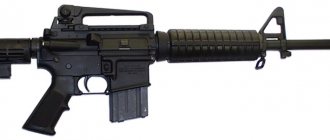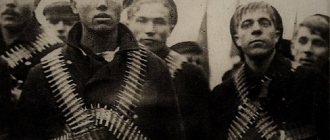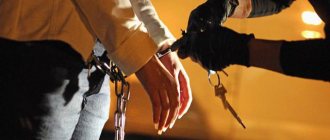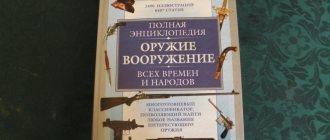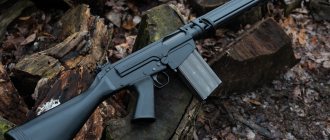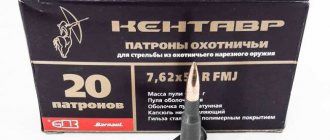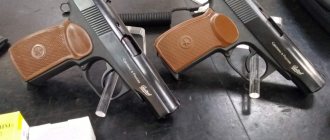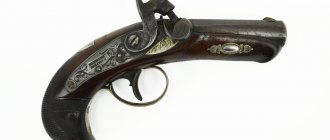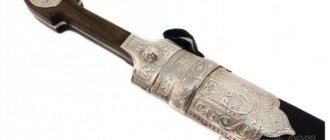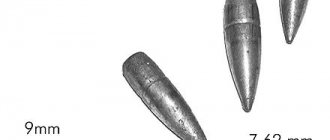Aircraft carrier "Hiryu"
Military equipment of Japan during the Second World War
— weapons and military equipment of Japan (aviation, armored vehicles, artillery, small arms, warships), used in the period from 1939 to 1945 (from the moment of the German attack on Poland in September 1939 until the signing of Japan’s surrender in September 1945).
Armored vehicles
Despite the Japanese military leadership's interest in armored vehicles, the speed of its development in Japan was lower than in European countries. The Japanese did not have large mechanized formations (as in the German or Soviet army), and separate armored forces were never formed in the imperial army. The basis of the armored fleet was small tanks Type 94 and Te-Ke, light Ha-Go, as well as medium Chi-Ha and Shinhoto Chi-Ha[1]. Chi-He and Chi-Nu were also produced in small quantities.
THE RISE AND DECLINE OF FIREARMS IN JAPAN
There is one more point - undoubtedly unparalleled in world history - which cannot be omitted in the narrative of the place of the sword in Japanese culture, no matter how brief it may be. This is the story of how the sword met the gun. In all countries of the world, this meeting immediately entailed the departure of the sword from the historical arena. But not in Japan. In those centuries when Japan was rocked by almost continuous internal wars (1200-1600), the country experienced tremendous changes not only in political, economic and social life, but also in the methods of warfare. Cavalry was no longer the main attacking force, as during the struggle between Minamoto and Taira. Among the command staff, warriors appeared who no longer rushed headlong towards the enemy, but led the battle from headquarters. The backbone of the armies that took to the battlefield in the second half of the Warring States period (1482-1558), which preceded the beginning of the unification of the country by Oda Nobunaga, were infantrymen (ashigaru),
wearing a minimum of armor and armed with spears eight to ten feet long, which replaced the old halberds. From now on, armies consisted of thousands and thousands of such warriors. Most of them were vassals of various daimyo, but among them there were also many recruits recruited from peasants - until Hideyoshi banned migration between classes by his decree.
In addition, in the second half of the sixteenth century, shortly before the final victory of the Tokugawa, another innovation appeared on the battlefield - firearms. It first became known in Japan in 1543, when three adventurers came ashore from a Portuguese merchant ship: “Two of them had arquebuses and everything necessary for shooting. Mr. Tokikata, the daimyo of Tanegashima, saw one of them take aim and shoot the duck. This is how firearms entered Japanese history.”
Tokikata bought a new weapon for a lot of money, and soon many craftsmen who had previously made swords began to produce guns, because the Japanese military leaders immediately realized the advantage of firearms over swords and spears, despite all the imperfections of the first samples. Already in 1549, Oda Nobunaga, who had just begun his almost successful struggle for control over the entire country, ordered 500 units of new weapons. In the next decade, arquebuses became widespread, and gunsmiths, who had previously forged swords, now conjured day and night to improve firearms. For example, they came up with a special device to protect the wick from rain, which allowed the shooter not to depend on weather conditions.
In 1575, Nobunaga very convincingly demonstrated the superiority of the new weapon. In the decisive battle of Nagashino, muskets showed themselves to be a terrible, all-destructive force. Nobunaga positioned his archers behind a zigzag palisade, high enough for horses to jump over, on the bank of a small river. The shooters were divided into three groups. This way, each had enough time to reload while the other two were firing. The Takeda clan army attacked in the traditional samurai manner of the Taira and Minamoto times: four successive waves of top-notch horsemen. However, they were forced to retreat after suffering heavy losses. Nobunaga took another step towards victory.
Many daimyo quickly realized how much the advent of firearms changed the nature of war, because warriors armed with spears and swords, no matter how well they mastered the martial arts, could not compete with soldiers armed with muskets. Of course, the latter were not invulnerable to arrows fired from crossbows, but, in any case, a bullet fired from a musket could finish off the most skillful and armored horseman before he could strike even one blow with a spear or sword. The same applied to the infantry spearmen. A real chase began for the firearms. For fifty years after the Battle of Nagashino, gunsmiths did not sit idle, and peasants were trained to shoot guns.
Firearms also played a role during the decisive battle of Sekigahara, in which Tokugawa Ieyasu defeated the army of the daimyo of the western provinces and finally established his power throughout Japan. At the beginning of the second day of the battle, the Tokugawa warriors fired several shots towards the camp on the enemy’s left flank to remind one of the commanders of the secret agreement reached earlier - at the turning point of the battle he should go over to the Tokugawa side. And then Kobayakawa Hideaki turned his troops against his recent allies. They did not expect such betrayal and fled. Ieyasu became the new master of the country.
In addition, we have data on how some units of Ieyasu’s army were armed, which once again confirms how much the importance of firearms in warfare has increased. Thus, in one of the detachments of 3,000 people, there were 420 horsemen (apparently armed with swords), 1,200 archers, 850 spearmen, 200 archers, the weapons of another 330 people are not reported. Another detachment, numbering 2000 people, had 700 archers and 550 spearmen. Thus, warriors with firearms made up about 40% of the troops. It should be noted that during the siege of Osaka Castle in 1614-1615, Ieyasu also deployed a significant amount of artillery and muskets. However, we must immediately make a reservation and indicate:
There were many other very influential factors, both military and general cultural, that played a role in the fact that Japan, having experienced a boom in firearms (1575-1625), eventually abandoned muskets and cannons and returned to the traditional sword. By looking back and being aware of subsequent events, one can see the telltale signs of this impending failure before it even happened. For example, the already mentioned decree of Hideyoshi on “sword hunting”, issued at the end of the sixteenth century. Muskets also fell under the “sword hunt.” Henceforth, only regular government troops received the right to wear them. It is obvious that even then in Japan they did not like the armed population and denied civilians the “right” to have the weapons they liked!
But there were other, more important manifestations of “anti-gun” sentiment. Even at the Battle of Sekigahara, “the main weapon was the spear.” There is another interesting manifestation of the fact that the musket did not completely supplant the sword. No matter how strange it may seem, not only horsemen and some infantrymen, but also, as in ancient times, archers and spearmen, and, most incredibly, the shooters themselves, all wore swords on their belts. The sword has forever become an integral part of the warrior. Spearmen, archers, and marksmen may not have had the rank of samurai, but they were Japanese warriors, and this high status was confirmed by the sword. The sword expressed everyone’s readiness to confirm at any moment that he follows the code of bushido and the warrior spirit of his ancestors, and to fight one on one.
At one time, attempts were made to carry out a certain “gradation” of weapons: so that the nobles would carry a sword, and the musket would be considered the weapon of the lower classes. However, the result was not only unsatisfactory, but even absurd. The situation became a stalemate, as evidenced by the following episode:
“That same year (1584) the two first generals of Japan met with their armies in the town of Komaki. Both of them remembered Nagashino's lessons well:
in both the army there were many shooters. As a result, neither side dared to begin. No one moved forward, no one accomplished great feats (unimaginable for the heirs of the glorious tradition of heroes of the Heike Monogatari). The commanders did not dare to send cavalry directly to the enemy’s muskets. Both armies dug trenches, sat in them and waited, from time to time firing volleys from muskets and firing explosive bombs from cannons in order to somehow kill time.
It all ended with the commanders entering into an alliance!
The mid-seventeenth century witnessed one of the most amazing paradoxes in history - the best gunsmiths in the world (Japanese) stopped making firearms! Why did this happen? Perrin gives several reasons to explain Japan's virtual abandonment of muskets and cannons. The first reason is that "Japan was too small to conquer China... and too warlike to allow anyone to conquer it." Genghis Khan became convinced of this in the thirteenth century, and the Chinese and Koreans in the sixteenth, during Hideyoshi’s campaigns in Korea. In addition, the country's island position and the policy of isolation pursued since 1600 equally prevented foreign aggression. The Tokugawa shogunate was not faced with the vital need to protect itself from its neighbors, and this sense of security did not leave it until its collapse in the nineteenth century. As compensation, the gunsmiths who were left without work were allowed to make swords again and were awarded honorary samurai titles.
The second reason why Japan eventually abandoned firearms was the attitude of the samurai themselves towards them. The historical situation of the second half of the sixteenth century dictated the need for its large-scale use, but with the rise to power of the Tokugawa and the reign of peace in the country in the seventeenth century (as well as the disappearance of a real military threat to Japan from its neighbors), the original prejudiced attitude of the samurai towards firearms again found a solid basis. After all, as Perrin notes, the samurai class received the gun rather indifferently: “Not one of those who considered themselves a real warrior, not one belonging to the bushi class, wanted to use it. Even Lord Oda Nobunaga refused to have this weapon in his personal arsenal.” The samurai simply did not need guns and cannons. And since there were quite a lot of samurai in the country - about two million, or eight percent of the population - and, most importantly, they were the ruling and dominant aristocratic class, their philosophy ultimately prevailed.
This attitude of samurai towards new weapons is easily explained. After all, the transition to artillery would deal a mortal blow to their worldview and life values. For samurai, a warrior with a sword was the personification of a man of high social status, invested with great responsibility, a man of courage and honor, which many years of dedicated martial arts training, primarily fencing, allowed him to become. But if during a battle volleys of guns thunder, then all these qualities become unnecessary. It is enough for some untrained peasant, cowardly and trembling with fear, to point a musket at his samurai opponent and shoot from a distance that does not allow the glorious warrior to demonstrate his valor and skill with the sword, for the latter to die an inglorious death. Why then many years of training? The musket threatened the complete destruction of samurai values, and therefore the military class itself, which is inseparable from them.
Finally, among the reasons for abandoning firearms were the so-called “general cultural” and “aesthetic” ones. An inner feeling told the Japanese that the guns were bad simply because they were foreign. And everything foreign, be it material or spiritual, weapons or religion, before being accepted, must be tested to determine whether it corresponds to Japanese traditions and whether the country needs it at all. The samurai tried to use firearms on a national scale and “considered” them unnecessary.
Of course, it could not evoke in the Japanese soul the aesthetic pleasure that the sword awakened in it. The crude practicality of the first primitive guns could not compete with the beauty and sophistication of a superbly crafted sword. Moreover, they were deprived of the mystical-religious symbolism embodied in its history and inextricably linked with its ownership. In addition, a warrior's honor lay in his sword, and in the Tokugawa era, the right to wear a sword indicated a person's high social status. If the sword was recognized as a work of art and was passed down in the family from generation to generation, then it was considered even more valuable than the life of its owner:
“Commander Hori Hidemasa besieged Lord Ake-chi Mitsuhide in his castle Sakamoto... When Lord Akechi realized that the castle was about to fall, he sent a message: “My castle is burning, and soon I will die. I have many magnificent swords that I have collected all my life. I wouldn’t want them to die with me... If you would stop the assault for a while, so that. I could give them to you, I could die in peace.” Mr. Hori agreed. The warriors stopped and swords wrapped in mats were lowered from the castle wall. Then the attacks resumed, and the next day the castle fell. Mr. Akechi died, apparently with a calm soul.”
In what other country than Japan could something like this happen!
The fact that it was operated purely mechanically was also considered a negative “aesthetic property” of firearms. Wielding a sword required a high degree of coordination of such qualities as physical strength, flexibility, sense of rhythm and intelligence. Loading a gun, aiming and pulling the trigger requires a minimum of skill and dexterity. The latest peasant recruit could master a gun in a few months; the sword required many years of hard work and training. In addition, there was something “unaesthetic” in the very pose that the person took during the shooting. As Perrin writes:
“In Japan there were very strict rules about how a person of good breeding should move, how he should stand, sit or kneel. In general, it was considered desirable for a person to always keep his knees and, if possible, his hands together - the so-called concentration of body, will and strength. Further, it was considered indecent to spread your elbows to the sides...
A person wielding a sword, especially a two-handed Japanese katana, would naturally move according to these rules. The one who fired the gun was more likely to violate them.”
It’s interesting how shooting manuals from the heyday of firearms tried to solve these problems and “ennoble” the shooters’ poses as much as possible:
“Soldiers are forced to crouch to the ground to shoot. Their elbows hurt, and the muscles in their hips are cramping... They have to spread their knees to the sides. However, don't allow your socks to be more than seven inches apart. It doesn't look nice."
All of the above factors ultimately prevailed. The new weapons first fell into disrepair and then disappeared altogether. Thus Japan once again became the “land of swords” and remained so for the next two and a half centuries. And then, ironically, Japan found itself in the position of Nobunaga's enemies at the Battle of Nagashino, when Captain Perry's 10-inch naval guns were aimed at defenseless Tokyo in 1853 and 1854. Samurai could not defend themselves with anything other than swords. And this time the fate of the sword was already decided. Japan devoted all its efforts to the production of cannons and other modern weapons. But was this movement forward or backward? From now on, swords began to be made only as personalized weapons for army officers and for connoisseurs of antiques.
However, tradition did not give up without a fight. Nine years after the last shogun abdicated power in 1867, and the Meiji Constitution reduced daimyos to civilians, banned the carrying of swords in public, and essentially deprived the samurai class of the basis of its existence, another minor but, perhaps the most symbolic outburst of “reverence for the sword.” A force of two hundred former samurai, dressed in traditional armor and armed with swords, attacked an army post. The samurai killed about three hundred people, but were soon defeated without difficulty. This happened in October 1876. And the next year, under the influence of this event, thirty thousand former samurai rebelled against the new government in the western province of Satsuma. However, they were no longer limited to swords and spears, but used all firearms available to them. The rebellion was suppressed, but only after six months of fierce fighting. The era of samurai and swords is gone forever, and the era of guns and regular armies has arrived.
THE ART OF THE SWORD
For seven centuries the warrior class and its culture dominated Japan, and for an even longer time the sword was considered not only the main weapon, but also a national symbol. Therefore, it is not surprising that in the training of a samurai the art of swordplay was given constant and paramount attention. As noted in Chapter 4, the sword took its classic shape through centuries of experience in battle. After the war between the Genji and Heike clans at the end of the twelfth century, it became clear that skill with the sword largely determines the outcome of any battle. This was the case until the appearance of firearms in Japan in the sixteenth century.
That is why warriors who wielded a sword well were always highly valued, and since such a warrior could only be “made” through long training, absolutely everyone needed fencing masters - heads of clans, daimyos, shoguns and at times even the imperial court. Future samurai began to master the sword in very early childhood: at the age of five they carried wooden swords, a little later - children's steel ones, and in adolescence they picked up a real adult sword. At the age of 15-16, the samurai participated in his first battle. And between battles, the warrior continued to tirelessly improve his combat skills, especially the art of fencing, bringing it to automatism. It is quite natural that under such conditions a “system” of a kind of competition developed, when future “employers” organized fights in search of battle-hardened warriors to train young ones, and fencing masters sought to get a position as mentors. Soon fencing schools (rto) appeared all over the country, each with its own main teacher and a special method. We would like to first say a few words about what qualities a good swordsman should have, and what techniques were used to develop his natural abilities.
SAMURAI TRAINING
First of all, the warrior was taught a set of standard blows - piercing and slashing - used in attack and defense, as well as the correct body movement when delivering them (positioning the legs, maintaining balance, how and where to hold the sword in various situations, etc.). Attack and defense were seen as interconnected components: any aggressive tactics should ideally include a defensive maneuver. In addition, for every defensive ploy there was an offensive “antidote”.
For example, against the classic attacking blow - the so-called “skull-splitting blow”, which was struck with a long sword (katana) from top to bottom - there was such a defensive technique: the warrior crouched and responded with a piercing lunge into the chest or neck of the attacker. It was possible to dodge the blow by slightly leaning to the side, and then, taking advantage of the fact that the enemy had lost his balance, hit him with a staff, a spear, a short sword or a fighting iron fan.
The “no-sword sword” technique was also used, especially in the late period, during the Tokugawa era. A description has reached us of how it was once used against Tokugawa Ieyasu. Yagyu Muneyoshi, who was already getting older, was considered a great master of this art, and in 1594 Ieyasu asked him to demonstrate his skill. Several of Ieyasu’s best warriors took turns trying to “hack” Muneyoshi, but he always managed to dodge their blows and knock his opponents to the ground. Then Ieyasu himself decided to fight the master:
“Muneyoshi leaned forward so that his arms hung down to his knees. Swinging his arms, he looked at Ieyasu. Ieyasu raised his sword high above his head and struck with force, intending to cut Muneyoshi's head. But at the last moment, Muneyoshi turned around and deflected the blow, grabbing the sword by the hilt. The next moment the sword flew through the air. Holding Ieyasu with his left hand (any other, less noble person would have been thrown to the ground), Muneyoshi only lightly hit him with his right fist in the chest. Ieyasu... staggered. Frowning, he said: “I am delighted! You have won" (Su-gawara).
The ideal of Yagyu Shinkage (“New Shadow”) stated that “the sword should not kill, but only complement the strength of its owner.” After the fight, Muneyoshi, out of politeness, gave Ieyasu a certificate of initiation into the secrets of the Yagyu fencing method (of which Ieyasu was extremely proud), and in return received guarantees of patronage and an offer to take the post of fencing teacher. But he refused, citing his advanced age, and offered his son Yagyu Munenori in his place. He himself soon became a monk in his native village of Yagyu. However, there is no mention of Ieyasu or any of his vassals adopting Muneyoshi’s technique.
Of course, there was a more or less standard set of rules for the position of the sword in a duel with an opponent. For example, holding a sword low means you run the additional risk of missing a slash or thrust to the head or torso. But for a good warrior, the enemy’s knowledge of this rule did not present any difficulties. So, one day the young Tsuka-hara Bokuden, wanting to become famous, challenged a famous warrior in the area named Ochiai Torazaemon to a duel. When the opponents came face to face, Bokuden lowered his sword low, which Ochiai considered a sign of either carelessness or excessive self-confidence. Alas, he was wrong:
Using the Battle Fan
Practicing drawing a sword and striking
Drawing a sword while simultaneously striking (above) and parrying a blow from a short sword with the left hand (below)
Drawing the sword from a sitting position
Drawing a sword while simultaneously striking (above) and parrying a blow from a short sword with the left hand (below)
Drawing the sword from a sitting position
“The fight ended almost instantly. The young warrior leaned forward slightly, the swords sparkled in the sun and... Ochiai lay on his back, and Bokuden stood at his shoulder with his magnificent sword... There could be no doubt that he cut Ochiai in two with one blow” (Sugawara).
Bokuden's seeming carelessness indicated precisely the opposite: high fencing technique coupled with tactical skill. Over the long period of time, while various fencers and their followers (schools, ryu) developed and improved their special methods, a huge variety of different types of strikes appeared. Thus, in one list the following are mentioned: “Sixteen blows can be struck with a Japanese sword, and each of them has its own name, for example: “four-way blow”, “sweeper”, “circular blow”, “point thrust”, “cutting the body” “,” “pear-splitting,” “thunderclap,” “slash,” and so on” (Brinkley).
Apparently, most of the above strikes are intended for use in a classic duel - a one-on-one duel. But what to do if you are attacked unexpectedly or if there are many attackers? Let us remember that even in the early period, both horsemen and foot soldiers began to carry the sword with the blade not down, but up. We said that when the sword is in this position, there is no need to draw it, raise it above the head and only then strike an attacking or defensive blow. The very movement of drawing the sword becomes effective.
The technique of drawing a sword while simultaneously striking was continuously improved and over time became the main element of fencing as a whole, receiving the name iaijutsu.
The advantages of this type of technique will be obvious when you consider that in those days in many Japanese houses the “walls” between rooms were thin sliding screens
(shoji)
made of paper, which could easily be broken by hand or pierced with a sword. The iaijutsu technique made it possible to strike from any position, sitting or standing, regardless of whether the person had time to prepare for battle or not. Naturally, he could almost always use such a technique. While the attacker was preparing to strike, the one under attack had the opportunity to dodge and at the same time draw his sword with an outward or upward blow, reminiscent of a blow from a whip, and thereby, if not kill, then discourage the enemy. If on the street a samurai was suddenly attacked by several enemies, then with the first “getting” blow he would incapacitate the enemy closest to him, and then deal with the rest.
Here is one of the exercises to improve iaijutsu technique:
“On command, the warrior, squatting in the middle of the mat (often blindfolded), jumped up and in one movement drew his sword from its sheath and struck at four or more “targets” mounted on poles along the edges of the mat. After which, without interrupting the single movement, he removed the sword and squatted down again. The time he spent on all these actions was recorded and, through careful and long training, was reduced to fractions of a second” (Ratti and Westbrook).
This training method aimed to combine situation assessment and striking into one lightning-like jerk.
In the technique of iaijutsu, there is clearly a desire to maximize the two most important elements in the art of wielding a sword (and hands too): speed and smoothness of movements. When it comes to speed, to achieve high skill in fencing, it is absolutely necessary to be able to choose the right time to strike. Many stories about famous fights testify that a keen sense of the moment when to attack or counterattack is decisive. This feeling can be hidden by pretending to be absent-minded or unprepared (like Bokuden); it will allow you to launch a counterattack a moment after the enemy has attacked; finally, it will make it possible to discern the enemy’s intentions by the shine of the eyes, by the trembling of a muscle, by a change in facial expression or body position. As we will see in the description of the famous duel between Musashi and Ganryu, the timing of an attack and the fraction of a centimeter make the difference between life and death.
Double Kick with One Knee Twist
A duel with two opponents. Parrying attacking blows and counterattacking. The katana is used as a kind of “lever”
Fencing with two swords at the same time
Fighting with two swords
In iaijutsu technique, fluidity is no less important. Movement with a sword in a sense resembles a dance: the stance is a change, one flows into the other so softly that no one will notice the difference between them. When several opponents attack one, the warrior makes real pirouettes between them, first striking from top to bottom, and then smoothly taking a different position and hitting the enemy from bottom to top. Spinning, bending, spinning in place and constantly swinging his sword, he performs a real dance of death.
In any situation - be it a formal duel, a clash during a bloody battle or a surprise attack - the warrior must decide for himself when to strike and which one. It is equally important to be able to quickly and accurately assess the enemy, his abilities and technique. During the battle there was no time left for thinking, but during the classic fights, which became more frequent during the Tokugawa period, there was a little more time - but not “rest” - to study the enemy. The enemy’s tactics and his “school” could be guessed by the placement of his legs, the position of his body, and finally, the way he held the sword. In the above-mentioned duel between Ieyasu and Muneyoshi, the latter, precisely by changing the position of the opponent’s legs, caught the moment when it was necessary to deviate slightly to the side. As a result, Ieyasu lost his balance.
His eyes spoke about the character and inner state of a person; his eyes revealed his feelings and moods. This is confirmed by two cases described in the sources. The first of them led to the emergence of a new school of fencing. Muneyoshi, already reputed to be a great master, came a long way to compete with another warrior, the founder of the Shinkage school named Kamiizumi Nobu-tsuna, about whom amazing things were told. Nobu-tsuna, having received an official challenge, asked his best student Hikida Toyogoro to fight Muneyoshi:
“They moved in circles, each looking at the other, trying to catch the enemy off guard, when suddenly Hikida rushed forward. Screaming loudly, he struck with his sword. Fukuro-shinai (bamboo stick) Hikida hit Muneyoshi on the forehead with a crash...
Muneyoshi, not believing in his defeat, swung his wooden sword, trying to counterattack, but he did not have time to do this, because Hikida screamed and hit him on the shoulder again.”
Then Nobutsuna, who was watching the fight, said that he would personally fight the loser Muneyoshi. After hesitating, Muneyoshi took the sword again:
“They looked at each other... Suddenly Muneyoshi threw down his sword, fell to his knees and bowed deeply... “Master Nobutsuna, let me become your student!” (Sugawara).
This is how the glorious school of Yagyu Shinkage arose. Later its representatives were accepted into the service of the Tokugawa shogunate. As a martial arts school, it still exists today. Nobutsuna recognized exceptional abilities and skill in Muneyoshi, despite the fact that he lost the fight. For two years, Muneyoshi was considered the first student, after which Nobutsuna shared with him the most intimate secrets of his method and appointed him as a successor.
The second story tells how one daimyo asked Yagyu Mitsuyoshi, the grandson of the founder of the Shinkage school, to give some lessons to his warriors. When all the warriors stood in front of Mitsuyoshi, ready to fight, he looked at them and suddenly quickly stepped back and sat down. Karasuyama Dend-zaemon, one of the warriors, also quickly retreated into the next room. Later it turned out that Karasuyama, who arrived on an errand to the daimyo, was not known to anyone here. But Mitsuyoshi, by his posture and the sparkle of his eyes, immediately recognized him as a great swordsman and did not want to “teach” him (Sugawara).
It was in the Shinkage school that the so-called “philosophy of gaze” arose: how to look at the enemy in order to ensure victory. Sugawara claims that it was the first school to actively incorporate "a spiritual element into martial arts theory." This is how she instructed to look at a potential enemy:
“In all types of martial arts, in all fine arts, and even more so in human behavior in general, a person’s movements are determined by his mind... In the Kage fencing school, a warrior reads the opponent’s mind by his stance and movements... What kind of mind can penetrate the opponent’s mind? Only the one who is trained and elevated to a state of perfect freedom. The mind must be clear and pure like a mirror, capable of reflecting the slightest changes in the enemy's mind... When you stand face to face with the enemy, do not reveal your mind. On the contrary, reflect the mind of the enemy just as water reflects the moon" (Sugawara).
Naval equipment
In Japan, much attention was paid to the navy and carrier-based aviation. The A6M Zero carrier-based fighter was considered one of the best in the world during the initial period of the war[4]. The Aichi D3A was used as a carrier-based bomber, and the Nakajima B5N was used as a torpedo bomber.
At the beginning of the war, the Imperial Japanese Navy had the aircraft carriers Soryu, Hiryu, Shokaku, Zuikaku, Kaga, Akagi, Shoho and Zuiho, as well as battleships of the Fuso, " Ise" and "Nagato". In addition, during the war, the world's largest battleships of the Yamato class were commissioned[5]. But even such a fairly large fleet was ultimately almost completely destroyed by the Allies.
Current state
The functions of the Supreme Commander-in-Chief are performed by the Prime Minister of Japan. Direct control of the troops and navy is carried out by the Ministry of Defense (until January 2007, the Directorate of National Defense) and the Joint Staff, which includes the headquarters of the ground, air and naval forces. According to the Japanese Ministry of Defense for 2014, the Ground Self-Defense Forces include 5 armies, the number of personnel is about 150 thousand people; In service there are about 700 battle tanks: Type-10, Type-90 and Type-74 produced by Mitsubishi Heavy Industries, about 750 armored combat vehicles and 1,350 artillery systems.
The Maritime Self-Defense Force (Navy) has 4 helicopter carriers, 29 destroyers, 14 frigates, 6 corvettes, 19 attack submarines, 30 mine countermeasures ships, 3 tank landing ships, 6 patrol ships and several dozen support vessels; number of personnel - about 50 thousand people;
Ranks and insignia
| Classification | Land SNA | Maritime SNA | Air SNA | ||||||||||||
| Rank | Insignia | Rank | Insignia | Rank | Insignia | ||||||||||
| Type A | Type B | Field | Type A | Type B | Type B | Field | Type A | Type B | Field | ||||||
| 幹部 Kambu Command Staff | 将官 Sho:kan Senior officers | 幕僚長 Bakuryocho: Chief of Staff | 陸上幕僚長Rikujo: bakuryocho: Full General or Army General[42] | 海上幕僚長Kaijo: bakuryo:cho: Full-admiral | 航空幕僚長Ko:ku: bakuryo:cho: Full general or Army general[42] of aviation | ||||||||||
| 将 Sho: Commander of an army or corps or division | 陸将Rikusho: Lieutenant General or Division General[42] | 海将Kaisho: Vice Admiral | 空将Ku:sho: Lieutenant General or Division General[42] of aviation | ||||||||||||
| 将補 Sho:ho:Brigade Commander | 陸将補Rikusho: Major General or Brigadier General[42] | 海将補Kaisho:ho: Rear Admiral | 空将補Ku:sho:ho: Major General or Brigadier General[42] of aviation | ||||||||||||
| 佐官 Sakan Senior officers | 1佐 Issa Regimental Commander | 1等陸佐Itto: Rikusa Colonel | 1等海佐Itto: kaisa Captain 1st Rank | 1等空佐Itto: ku:sa Aviation Colonel | |||||||||||
| 2佐 Nisa Battalion Commander | 2等陸佐Nito: Rikusa Lieutenant Colonel | 2等海佐Nito: kaisa 2nd Rank Captain | 2等空佐Nito: ku:sa Air Force Lieutenant Colonel | ||||||||||||
| 3佐 SansaZam. battalion commander | 3等陸佐Santo: Rikusa Major | 3等海佐Santo: kaisa 3rd Rank Captain | 3等空佐Santo:ku:sa Aviation Major | ||||||||||||
| 尉官 Ikan Junior officers | 1尉 Ichii Company Commander | 1等陸尉Itto: Rikui Captain | 1等海尉Itto: kai Lieutenant Captain | 1等空尉Itto:ku:i Aviation Captain | |||||||||||
| 2尉 NiiZam. company commander | 2等陸尉Nito: Rikui First Lieutenant | 2等海尉Nito: kai First Lieutenant of the Navy | 2等空尉Nito: ku:i First Lieutenant of Aviation | ||||||||||||
| 3尉 SanyiPlatoon Leader | 3等陸尉Santo: Rikui Lieutenant | 3等海尉Santo: kai Navy Lieutenant | 3等空尉Santo:ku:i Air Lieutenant | ||||||||||||
| 准尉 Junyi Ensigns and midshipmen | 准陸尉Junrikui Ensign | 准海尉Junkai Midshipman | 准空尉Junku:i Ensign of Aviation | ||||||||||||
| 曹士 So:si Sergeants and soldiers Petty Officers and sailors | 曹 So: Sergeants and petty officers | 曹長 So:cho: Sergeant major of a company or battalion | 陸曹長Rikusōcho: Senior Sergeant | 海曹長Kaisocho: Chief Petty Officer | 空曹長Ku:so:cho: Senior Aviation Sergeant | ||||||||||
| 1曹 Isso: Deputy. platoon commander | 1等陸曹Itto: rikuso: Sergeant 1st Class | 1等海曹 Itto: kaiso: Sergeant Major 1st article | 1等空曹Itto: ku:so: Air Sergeant 1st Class | ||||||||||||
| 2曹 Niso: Squad Leader | 2等陸曹Nito: Rikuso: Sergeant 2nd Class | 2等海曹 Nito: kaiso: Sergeant Major 2nd article | 2等空曹Nito: ku:so: Air Sergeant 2nd Class | ||||||||||||
| 3曹 Sanso: Pom. squad commander | 3等陸曹Santo: Rikuso: Sergeant 3rd Class | 3等海曹Santo:kaiso: Petty Officer 3rd Article | 3等空曹Santo:ku:so: Air Sergeant 3rd Class | ||||||||||||
| 士 Xi Soldiers and Sailors | 士長 Shicho: Highly qualified soldier | 陸士長Rikushicho: Corporal | 海士長Kaishicho: Senior Sailor | 空士長Ku:shicho: Aviation Corporal | |||||||||||
| 1士 Issi A soldier with a military specialty | 1等陸士Itto: rikushi Private 1st Class | 1等海士Itto: kaishi Sailor of the 1st article | 1等空士Itto: ku:si Aviation Private 1st Class | ||||||||||||
| 2士 Nishi Trained Soldier | 2等陸士Nito: rikushi Private 2nd Class | 2等海士Nito: kaishi Sailor of the 2nd article | 2等空士Nito: ku:si Aviation Private 2nd Class | ||||||||||||
| Abolished in 2010 | |||||||||||||||
| 3士 Sanshi Untrained Soldier | 3等陸士Santo: Rikushi Private 3rd Class | 3等海士Santo: kaishi Sailor of the 3rd article | 3等空士Santo: ku:si Aviation Private 3rd Class | ||||||||||||
| 自衛官候補生 Jieikan ko:hosei Cadets | 自衛官候補生Jieikan ko:hosei Recruit | — | 自衛官候補生Jieikan ko:hosei Recruit | 自衛官候補生Jieikan ko:hosei Recruit | |||||||||||
Content
- 1 Chemical weapons 1.1 History of creation
- 1.2 Research and training organizations
- 1.3 Experimental studies of BOV
- 1.4 Chemical weapons production
- 1.5 Use of chemical weapons
- 1.6 Concealing traces of chemical weapons
- 1.7 The problem of disposal of buried chemical weapons
- 1.8 Signing of the Chemical Weapons Convention
- 2.1 History of creation
